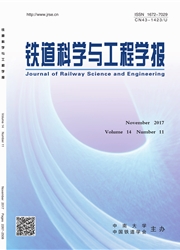

 中文摘要:
中文摘要:
横风作用下,行驶在桥梁上的列车和桥梁之间存在明显的气流相互干扰,增加列车事故发生的可能性。为研究高速列车与桥梁之间的相互气动影响,基于大型计算流体力学软件Fluent,采用三维、定常、不可压缩Navier—Stokes方程,选用适应性良好的Realizablek—s湍流模型,模拟风洞试验中横风(均匀风0°攻角,90°风偏角)作用下高速列车与32m简支梁桥系统空气动力学行为。研究结果表明:风速在5~25m/s变化时对车桥气动力系数影响不大;车下桥梁受到列车的干扰,阻力系数增大、升力系数和倾覆力矩系数(以下简称为力矩系数)均减小;桥上列车侧力系数、升力系数及力矩系数较平坦地面时均增大,即桥上列车运行安全性更差。
 英文摘要:
英文摘要:
Under the effect of crosswind, there exists obvious mutual airflow interaction between high - speed trains and the bridge, which would augment the probability of train accident. In order to estimate the mutual effect, the aerodynamic behavior of high - speed vehicles and 32 m span simply - supported beam bridges was investigated with large -scale computational fluid dynamics software Fluent applying three -dimensional, steady, incompressible Navier- Stokes equations and carefully selected Realizable k -ε turbulent model. Thereinto, wind tunnel experiment was conducted to simulate the crosswind with corresponding parameters - uniform wind being 0°attack angle and 90° angle of wind deflection. The results show that the wind velocities in the range of 5 - 25 m/s have insignificant impact on the aerodynamic coefficient. When the bridge is under the disturbance of trains, the drag coefficients increases while the lift coefficients and overturning moment coefficients ( call moment coefficients for short ) decrease. Meanwhile, the magnitude of drag coefficients, lift coefficients and moment coefficients of trains gained on the bridge is greater than those derived on flat ground, which shows less security of trains moving on the bridge.
 同期刊论文项目
同期刊论文项目
 同项目期刊论文
同项目期刊论文
 Study on internal pressure characteristics and design value for a 220m high hyperbolic cooling tower
Study on internal pressure characteristics and design value for a 220m high hyperbolic cooling tower Aerodynamic characteristics of a trailing rail vehicles on viaduct based on still wind tunnel experi
Aerodynamic characteristics of a trailing rail vehicles on viaduct based on still wind tunnel experi Sensitive factors research for track-bridge interaction of Long-span X-style steel-box arch bridge o
Sensitive factors research for track-bridge interaction of Long-span X-style steel-box arch bridge o 期刊信息
期刊信息
